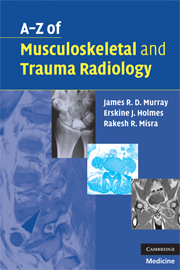Book contents
- Frontmatter
- Contents
- Acknowledgements
- Preface
- List of abbreviations
- Section I Musculoskeletal radiology
- Achilles tendonopathy/rupture
- Aneurysmal bone cysts
- Ankylosing spondylitis
- Avascular necrosis – osteonecrosis
- Femoral-head osteonecrosis
- Kienböck's disease
- Back pain – including spondylolisthesis/spondylolysis
- Bone cysts
- Bone infarcts (medullary)
- Charcot joint (neuropathic joint)
- Complex regional-pain syndrome
- Crystal deposition disorders
- Developmental dysplasia of the hip (DDH)
- Discitis and vertebral osteomyelitis
- Disc prolapse – PID – ‘slipped discs’ and sciatica
- Diffuse idiopathic skeletal hyperostosis (DISH)
- Dysplasia – developmental disorders
- Enthesopathy
- Gout
- Haemophilia
- Hyperparathyroidism
- Hypertrophic pulmonary osteoarthropathy
- Irritable hip/transient synovitis
- Juvenile idiopathic arthritis
- Langerhans-cell histiocytosis
- Lymphoma of bone
- Metastases to bone
- Multiple myeloma
- Myositis ossificans
- Non-accidental injury
- Osteoarthrosis – osteoarthritis
- Osteochondroses
- Osteomyelitis (acute)
- Osteoporosis
- Paget's disease
- Perthes disease
- Pigmented villonodular synovitis (PVNS)
- Psoriatic arthropathy
- Renal osteodystrophy (including osteomalacia)
- Rheumatoid arthritis
- Rickets
- Rotator-cuff disease
- Scoliosis
- Scheuermann's disease
- Septic arthritis – native and prosthetic joints
- Sickle-cell anaemia
- Slipped upper femoral epiphysis (SUFE)
- Tendinopathy – tendonitis
- Tuberculosis
- Tumours of bone (benign and malignant)
- Section II Trauma radiology
Perthes disease
from Section I - Musculoskeletal radiology
Published online by Cambridge University Press: 22 August 2009
- Frontmatter
- Contents
- Acknowledgements
- Preface
- List of abbreviations
- Section I Musculoskeletal radiology
- Achilles tendonopathy/rupture
- Aneurysmal bone cysts
- Ankylosing spondylitis
- Avascular necrosis – osteonecrosis
- Femoral-head osteonecrosis
- Kienböck's disease
- Back pain – including spondylolisthesis/spondylolysis
- Bone cysts
- Bone infarcts (medullary)
- Charcot joint (neuropathic joint)
- Complex regional-pain syndrome
- Crystal deposition disorders
- Developmental dysplasia of the hip (DDH)
- Discitis and vertebral osteomyelitis
- Disc prolapse – PID – ‘slipped discs’ and sciatica
- Diffuse idiopathic skeletal hyperostosis (DISH)
- Dysplasia – developmental disorders
- Enthesopathy
- Gout
- Haemophilia
- Hyperparathyroidism
- Hypertrophic pulmonary osteoarthropathy
- Irritable hip/transient synovitis
- Juvenile idiopathic arthritis
- Langerhans-cell histiocytosis
- Lymphoma of bone
- Metastases to bone
- Multiple myeloma
- Myositis ossificans
- Non-accidental injury
- Osteoarthrosis – osteoarthritis
- Osteochondroses
- Osteomyelitis (acute)
- Osteoporosis
- Paget's disease
- Perthes disease
- Pigmented villonodular synovitis (PVNS)
- Psoriatic arthropathy
- Renal osteodystrophy (including osteomalacia)
- Rheumatoid arthritis
- Rickets
- Rotator-cuff disease
- Scoliosis
- Scheuermann's disease
- Septic arthritis – native and prosthetic joints
- Sickle-cell anaemia
- Slipped upper femoral epiphysis (SUFE)
- Tendinopathy – tendonitis
- Tuberculosis
- Tumours of bone (benign and malignant)
- Section II Trauma radiology
Summary
Characteristics
A form of avascular necrosis of the femoral head, probably secondary to disruption of the blood supply to the femoral epiphysis.
Commonest between the years of 4 to 8.
Male predominance with a ratio of 5 to 1.
Occurs in 1 in 10,000 and is bilateral in 10%.
Clinical features
Presents with a limp or, or if bilateral with a painful gait.
Pain may be referred to the knee or medial thigh.
On examination, hip abduction and internal rotation are limited.
Onset may be insidious and thus the child may present late with shortening on the affected side and disuse atrophy of muscle.
Onset prior to age 8 confers better prognosis.
Radiological features
Radiographic features are usually well seen by time of presentation.
Femoral epiphysis appears smaller on the affected side.
Femoral head sclerosis with adjacent bone demineralisation.
Slight widening of the joint space.
Metaphyseal lucent areas – Gage's sign.
Subchondral fracture best seen on the frog lateral view.
Sclerotic fragmentation of the femoral head.
Coxa magna – widened flatter femoral head secondary to remodelling.
CT may show loss of normal trabecular pattern.
Bone scan will show decreased uptake followed by increased uptake as repair and secondary degenerative change predominate.
MRI is sensitive, again with varying appearances depending on the stage.
Management
Initial management involves bed rest and analgesia. In young presentation disease (< 8 years) non-operative treatment is most common.
Maintain the femoral head within the acetabulum.
Surgical osteotomy may be appropriate in selected cases.
Herring (J. Bone Jt Surg. Am. 2005) has shown surgical management with femoral or pelvic osteotomy is beneficial in late presentation (after age 8) for cases of moderate severity.
Surgery in late-onset severe disease is controversial.
- Type
- Chapter
- Information
- A-Z of Musculoskeletal and Trauma Radiology , pp. 113 - 114Publisher: Cambridge University PressPrint publication year: 2008



